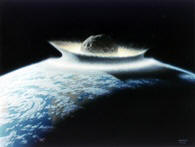
300, Moon
What was left of rocks and ice in the Oort planets party was heavily damaged by collisions. A large amount of rocks and ice was spread out in the inner orbits of the star system. Like in the previous round, the objects headed the same direction as the inner planets. Two of the Terrestrial planets were at collision course. The Oort planet sailed in the fourth planetís orbit though. But the fourth planet itself was on the other side of the star and passed the inner system without any encounter.
The moon
that hung on to the Oort planet from the sixth planet, had lost its grip
long ago. The gravitation force of the second planet pulled the moon
towards itself, along with a heavily load of ice. Even though the moon
and the planet had the same direction, the moon hit the planet with
considerable force. It split the planetís single continental plate into
several parts. The plates started a slow drift from each other. Then the
moon ricocheted into space again. At the planet, 1 km high waves spread
in circles from the point of impact. These gigantic flood waves moved
over all land but lost their height during the way. When the waves
passed on the other side, their synergy made a new gigantic peak. Then
the waves sailed several time around the globe and washed almost all
unprotected life to the seas. The disturbance was so hard that the
largest ice-age ever begun.
The moon ricocheted into space again. It was not damaged much, though. After some million years, it found a stable orbit around its new mother planet. However, its core was shaken hard and out of the center of the moon. One side of the moon got larger gravity than the other. Consequently, one side of the moon was always faced towards the second planet. During the following millions of years, the planet and the moon caught each other. The moon got a new mother planet and spent several years to adapt to its new orbit.
The third planet was rammed heavily by large rocks and ice as well. The massive series of impacts did make most species distinct. However, the insect were far better to adapt to the years of apocalyptical environment. In fact, the crises caused an advantage for the insects in the race of survival of the fittest.
The first planet, with its hot core and boiling atmosphere, was basically hit by metallic rocks. Several new eruptions melted the metallic chemicals to gas.
So, Lucie said, the four terrestrial planets had their rather different developments because of the Oort planetís interference of the solar system. Klype nodded. It is not unlikely, she added. The thought a lot about the scenes and what it possibly could mean. However, she was no further to the conclusion, except that it might have been dramatically. She wanted more of this scene, but for now, the development of life seemed much more important.
But, she said slowly. Klype got nervous. I have been checking some data myself. That moon scenario is most likely to have happened billions of years ago. It must have been a much smaller, object hitting exact there, she said and pointed to the north-east area of the largest continent. Please, do not tempt to fool me and my superiors. They can be very unpleasant to about untruth. Klype nodded silently.
After a while of quite, she ordered Klype to correct the error, and then focus on life on Terra from this time. She left a couple of cookies before she went. Klype started right away. Boring, boring, boring, he thought to himself, the same old story over again. Giant rock crash planet, surface cracks, magna erupts, torched planet, deserts, toxic rain, ice age, mass eradication. Just some cut and past and modification of other scenarios, and it is complete in minutes.